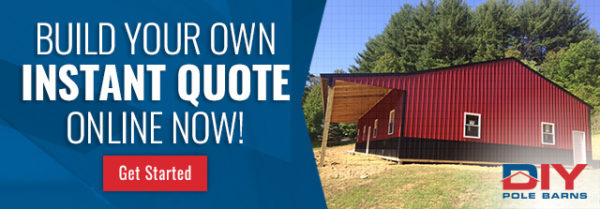Pole Barn Trusses
Each do-it-yourself pole barn kit sold by DIY Pole Barns includes wood pole barn trusses – ranging anywhere from 12 feet to 40 feet wide, depending on the structure. They are spaced every four feet. I am frequently asked questions regarding our wood trusses. One of the most often asked questions is about attic storage options and the lumber sizes. I hope to shine some light today on the importance, or lack thereof, of the lumber used in trusses.
First, let’s get started by defining the components of an engineered wood truss. First, the lumber member that makes up the roofline of the truss is called the top chord. Conversely, the ceiling boards are called the bottom chord. The lumber that connects the two are called webs.
Common vs. Scissor Trusses
Now, how these components are arranged and their shapes they define the truss type. At DIY Pole Barns, our main focus is on two types of trusses; common and scissor. Common trusses look like perfect triangles and are the most popular type of truss in pole buildings. Scissor trusses are also known as cathedral ceiling trusses. They allow for extra headroom by increasing the ceiling height along with the roof height.
When it comes to light storage, the common trusses are the best option. We utilize the Fink truss style. This allows for a triangle shape in the center of the truss. This accommodates a space down the center of your truss to store light items such as Christmas ornaments and garden tools. These pole barn trusses are not designed for heavy items such as engine parts and book collections.
As for the lumber sizes, the best answer to that question is “It doesn’t matter”! What? How can that be? Everyone knows that a 2×6 is stronger than a 2×4!! There is a lot more to the story than just the size of the lumber. There are many lumber grades that are not understood or even known about outside of the lumber industry.
We have all heard of #2 and better lumber. That is what the local home improvement store sells. But there is also #3, #1, Select Structural, MSR and MEL. MSR (Machine Stress Rated) and MEL (Machine Evaluated Lumber) are industrial grades of lumber. It is specified as being stronger than the visually graded lumbers, #3, #2, and #1, and can sometimes withstand more loading than larger size lumber of a lower grade.
Along with the different lumber grade are different lumber species. SPF (Spruce, Pine, Fir), Southern Pine, Douglas Fir-Larch, and Hemlock fir are all the different species used in wood trusses and all have their own structural characteristics.
Don’t Be Confused By Pole Barn Trusses
If this all sounds confusing, well you’re right. It’s better to leave this to the professional pole barn truss designer that work alongside structural engineers. They focus on manufacturing trusses meet your specific needs and meet your local building codes. Every truss designer has his own signature style. One will like to use a 2×6 #1 yellow pine with a certain mending plate where another will like to use a 2×4 MSR 2400 with an extra web. At the end of the day, “It doesn’t matter”. If the truss is designed in a way the engineer will approve it, then it doesn’t matter the lumber size that was used.
I hope this clears up the muddy water of truss design.
If you’re ready to build your pole barn today, lock in a quote with DIY Pole Barns with our Instant Quote tool! Have questions? Call our knowledgeable staff at (937) 547-9100.




